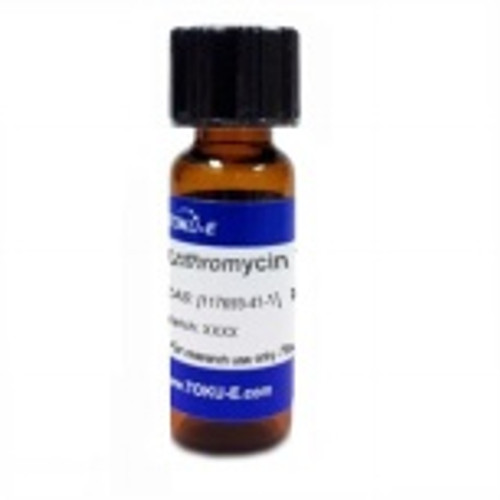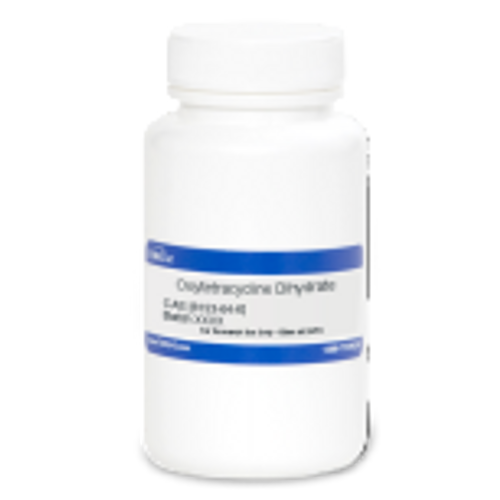Azithromycin Dihydrate is a broad-spectrum antibiotic derived from Erythromycin that belongs to the azalide subclass of the Macrolide family. The macrolide family possess anti-inflammatory properties independent of their bactericidal/bacteriostatic actions, and Azithromycin demonstrates anti-immunomodulatory/anti-inflammatory properties. The compound is effective against many Gram-negative and Gram-positive bacteria and certain Mycoplasma species. Azithromycin is a senolytic compound that selectively attacks and kills senescent cells with high efficiency. Azithromycin has been used in research studies on Coronavirus, SARS-CoV-2.
Azithromycin Dihydrate is soluble in DMSO and ethanol, but sparingly soluble in aqueous solution.
We also offer the following derivatives:
| Mechanism of Action | Macrolide antibiotics inhibit bacterial growth by binding to the 70S ribosome (specifically the 50S subunit) preventing peptide bond formation and translocation during protein synthesis. Resistance is attributed to mutations in 50S rRNA preventing binding of Azithromycin and allowing the cell to synthesize error-free proteins. |
| Spectrum | Azithromycin is effective against several Gram-positive and Gram-negative bacteria and certain Mycoplasmas. |
| Microbiology Applications | Azithromycin Dihydrate is commonly used in clinical in vitro microbiological antimicrobial susceptibility tests (panels, discs, and MIC strips) against Gram-positive and Gram-negative microbial isolates. Medical microbiologists use AST results to recommend antibiotic treatment options. Representative MIC values include:
For a representative list of Azithromycin MIC values, click here. Azithromycin has also been shown to have antiviral properties for respiratory viruses, such as rhinoviruses, by decreasing the synthesis of intercellular adhesion molecules such as ICAM-1 that are used by the virus for adhesion. Azithromycin is a promising candidate for the treatment of the COVID-19 disease. According to the literature, a number of clinical trials are currently underway on the use of Azithromycin for COVID-19 disease (Parra-Lara et al, 2020). |
| Eukaryotic Cell Culture Applications | Azithromycin influence on the production of pro-inflammatory cytokines and chemokines by human gingival fibroblasts (HGF) was studied in vitro. Azithromycin was found to suppress P. gingivalis LPS-induced cytokine/chemokine protein production in HGF (Doyle et al, 2015).
Azithromycin pretreatment induced antiviral mechanisms in Cystic Fibrosis (CF) bronchial epithelial cells. Pulmonary exacerbations are often associated with rhinoviruses. Azithromycin reduced rhinovirus replication 7-fold without inducing cell death, possibly through amplifying the antiviral response mediated by the IFN pathway (Schögler et al, 2015). |
| CAS Number | 117772-70-0 (dihydrate); (anhydrous); 121479-24-4 (monohydrate) |
| Molecular Formula | C38H72N2O12 • 2H2O |
| References |
Doyle CJ et al (2015) Azithromycin suppresses P. gingivalis LPS-induced pro-inflammatory cytokine and chemokine production by human gingival fibroblasts in vitro. Clin. Oral Investig. 19(2):221-227 PMID 24806810 Medina, CA et al (2013) Azithromycin treatment increases survival of high-risk corneal allotransplants. Cornea 32 (5): 658-666 PMID 23407315 Sargiacomo C, Sotgia F, Lisanti MP (2020) COVID-19 and chronological aging: senolytics and other anti-aging drugs for the treatment or prevention of corona virus infection? Aging (Albany NY) 12:6511–6517 Schögler A et al (2015) Novel antiviral properties of Azithromycin in cystic fibrosis airway epithelial cells. Eur. Resp. J 45(2):428-439 Parra-Lara LG, Martínez-Arboleda JJ and Rosso F (2020) Azithromycin and SARS-CoV-2 infection: Where we are now and where we are going. J. Glob. Antimicrob. Resist. 22:680–684 PMID 32622008 |
| MIC | Aggregatibacter actinomycetemcomitans| <2|| Bacillus circulans| ≤0.03 - >32|| Bacteroides capillosus| ≤0.03 - 0.25|| Bacteroides tectum | 0.5 - 2|| Bacteroides ureolyticus| ≤0.03 - 0.25|| Bifidobacterium breve| ≤0.03 - >32|| Bifidobacterium longum| ≤0.03 - >32|| Bilophila wadsworthia| 1 - 16|| Borrelia afzelii| 0.0004 - 0.0156|| Borrelia bissettii| 0.0039 - ?|| Borrelia burgdorferi| ≤0.0002 - 3|| Borrelia garinii| 0.0004 - 0.0156|| Borrelia valaisiana| 0.0009 - ≤0.015|| Brevibacterium spp.| ≤0.03 - >128|| Brucella melitensis| <0.125 - >256|| Campylobacter concisus| ≤0.03 - 0.5|| Campylobacter gracilis | ≤0.03 - 0.5|| Campylobacter mucosalis| ≤0.03 - 0.5|| Campylobacter rectus| ≤0.03 - 0.5|| Campylobacter showae| ≤0.03 - 0.5|| Campylobacter spp.| 0.25|| Campylobacter sputorum| ≤0.03 - 0.5|| Candida| >32|| Capnocytophaga ochracea| ≤0.03 - 0.25|| Chlamydia pneumonia| 0.015 - 0.5|| Chlamydia trachomatis| 0.016 - 0.125|| Chlamydophila pneumonia| 0.012 - 0.5|| Citrobacter koseri| 2 - >8|| Clostridium clostridioforme| 0.125 - >32|| Clostridium difficile| 1 - >32|| Clostridium innocuum| 0.125 - >32|| Clostridium ramosum| 0.125 - >32|| Collinsella aerofaciens| ≤0.03 - 0.25|| Corynebacterium afermentans| 0.03 - >128|| Corynebacterium amycolatum| 0.125 - >128|| Corynebacterium jeikeium| 0.06 - >128|| Corynebacterium minutissimum| ≤0.03 - >128|| Corynebacterium pseudodiphtheriticum| ≤0.015 - >128|| Corynebacterium spp.| 0.03 - >128|| Corynebacterium striatum| 0.03 - >128|| Corynebacterium urealyticum| ≤0.015 - >128|| Coryneform (CDC group| 0.03 - >128|| Dialister pneumosintes| ≤0.03 - 0.25|| Edwardsiella hoshinae | 2 - 16|| Edwardsiella ictaluri | 0.5 - 32|| Edwardsiella tarda| 4 - 16|| Eikenella corrodens| 0.25 - 8|| Enterobacteriaceae| 0.25 - 128|| Enterococcus| 0.06 - ≥512|| Erysipelothrix rhusiopathiae| 0.03|| Escherichia coli| ≤0.0156 - 512|| Eubacterium lentum| ≤0.03 - 0.25|| Eubacterium saburreum| ≤0.03 - 0.125|| Eubacterium spp.| ≤0.03 - 0.25|| Eubacterium timidum| ≤0.03 - 0.25|| Eubacterium yurii| ≤0.03 - 0.25|| Finegoldia magna| ≤0.03 - >32|| Fusobacterium gonidiaformans | 0.06 - 32|| Fusobacterium mortiferum| 1 - >32|| Fusobacterium naviforme| ≤0.03 - 32|| Fusobacterium necrogenes | 1 - >32|| Fusobacterium necrophorum| ≤0.03 - 32|| Fusobacterium nucleatum| ≤0.03 - >64|| Fusobacterium russii | 0.03 - 32|| Fusobacterium ulcerans | 1 - >32|| Fusobacterium varium| 2 - >32|| Haemophilus influenzae| 0.001 - >256|| Helicobacter pylori| 0.06 - >128|| Klebsiella oxytoca| 8 - >8|| Lactobacillus catenaforme| ≤0.03 - >32|| Lactobacillus delbrueckii | ≤0.03 - >32|| Lactobacillus oris| ≤0.03 - >32|| Lactobacillus plantarum| ≤0.03 - >32|| Lactobacillus spp. | ≤0.03 - >32|| Legionella pneumophila| 0.008 - 2|| Legionella spp.| 0.12 - 2|| Leptotrichia buccalis| ≤0.03 - 1|| Listeria monocytogenes| 0.125 - 2|| Micromonas micros| ≤0.03 - 0.5|| Moraxella catarrhalis| ≤0.008 - ≥64|| Morganella morganii| 8 - >8|| Mycobacterium abscessus| 0.5 - >64|| Mycobacterium avium| 4 - >256|| Mycobacterium chelonae| 0.25 - 4|| Mycobacterium fortuitum| 1 - >64|| Mycobacterium malmoense| 16|| Mycobacterium mucogenicum| 0.12 - 1|| Mycobacterium peregrinum| 0.5 - 4|| Mycobacterium simiae| 4|| Mycobacterium xenopi| 1|| Mycoplasma fermentans| 2 - 8|| Mycoplasma genitalium| ≤0.015 - 0.03|| Mycoplasma hominis| 32 - >64|| Mycoplasma hyopneumoniae| 0.0625 - >64|| Mycoplasma penetrans| 0.12 - 0.5|| Mycoplasma pneumonia| 0.00024 - 3.2|| Neisseria cinerea| 0.5 - 4|| Neisseria lactamica| 1 - 2|| Neisseria meningitidis| ≤0.03 - 2|| Neisseria mucosa| 0.06 - 8|| Neisseria perflava/sicca| 0.25 - 4|| Neisseria polysaccharea| 0.03 - 0.25|| Oerskovia spp.| 0.03 - >128|| Olsenella uli | ≤0.03 - >32|| Pasteurella multocida| 0.05|| Peptostreptococcus anaerobius| ≤0.03 - >32|| Peptostreptococcus asaccharolyticus| 0.5 - >32|| Peptostreptococcus magnus| 2 - >32|| Peptostreptococcus micros| 0.5 - 1|| Peptostreptococcus prevotii| 0.06 - >32|| Peptostreptococcus spp.| 2 - 4|| Porphyromonas asaccharolytica| 0.125 - >32|| Porphyromonas cangingivalis | 0.125 - 1|| Porphyromonas canoris | 0.125 - 0.5|| Porphyromonas cansulci | 0.125 - 1|| Porphyromonas circumdentaria | 0.125 - 1|| Porphyromonas endodontalis| ≤0.03 - 0.25|| Porphyromonas gingivalis| ≤0.03 - 8|| Porphyromonas levii | 0.125 - 1|| Porphyromonas macacae | 0.125 - 1|| Prevotella bivia| 0.25 - >32|| Prevotella buccae| 0.06 - >32|| Prevotella buccalis| 0.03 - >32|| Prevotella corporis| ≤0.03 - 8|| Prevotella dentalis| ≤0.03 - >32|| Prevotella denticola| 0.06 - >32|| Prevotella disiens| ≤0.03 - >32|| Prevotella heparinolytica | 0.5 - 1|| Prevotella intermedia| ≤0.03 - >32|| Prevotella loescheii| ≤0.03 - 32|| Prevotella melaninogenica| ≤0.03 - >32|| Prevotella nigrescens| ≤0.03 - >32|| Prevotella oralis| ≤0.03 - >32|| Prevotella oris| ≤0.03 - >32|| Prevotella pallens| ≤0.03 - >32|| Prevotella spp.| ≤0.03 - >32|| Prevotella tannerae| ≤0.03 - 8|| Prevotella zooglioformans| ≤0.03 - >32|| Propionibacterium avidum| ≤0.03 - >32|| Pseudomonas aeruginosa | 125 - 2000|| Rhodococcus equi| 0.03 - >4|| Salmonella spp.| 1|| Selenomonas flueggei | ≤0.03 - 0.25|| Selenomonas infelix| ≤0.03 - 0.25|| Selenomonas spp.| ≤0.03 - 0.25|| Shigella spp.| 0.5|| Staphylococci | 0.06 - ≥64|| Staphylococcus aureus| 0.12 - >128|| Staphylococcus epidermidis| <0.12 - >128|| Staphylococcus haemolyticus| 0.25 - >8|| Staphylococcus hominis| 0.12 - >8|| Staphylococcus lugdunensis| 0.25 - >8|| Staphylococcus pneumonia| >16|| Staphylococcus saprophyticus| 0.12 - >64|| Staphylococcus spp. | 0.5 - >32|| Staphylococcus warneri| 0.12 - >8|| Streptococci| ≤0.008 - >256|| Streptococcus agalactiae| 0.008 - >64|| Streptococcus anginosus| 0.008 - >8|| Streptococcus bovis| 0.008 - >8|| Streptococcus constellatus| 0.008 - >8|| Streptococcus intermedius| 0.008 - >8|| Streptococcus mitis| 0.008 - >8|| Streptococcus oralis| 0.008 - >8|| Streptococcus pneumonia| 0.004 - >512|| Streptococcus pyogenes| 0.001 - >256|| Streptococcus salivarius| 0.008 - >8|| Streptococcus sanguinis| 0.008 - >8|| Streptococcus spp.| ≤0.06 - >8|| Turicella otitidis| 0.03 - >128|| Ureaplasma spp.| 0.063 - 4|| Ureaplasma urealyticum | 0.06 - 0.5|| Veillonella spp.| ≤0.03 - >32|| |








